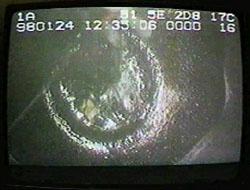
|

|
|
|
©
Per Olof Hulth
|
|
|
The
optical module submerged in water, nearly two miles below
the surface of the ice.
|
|
|
|

A
literary essay about AMANDA by Francis Halzen
page 5
Why
are we looking for neutrinos that have passed through the
earth? Muons generated by cosmic rays also bombard the earth
constantly from every direction, and some of them can travel
through miles of ice before petering out. But no muon can
cross the entire planet—as much as 8,000 miles of dense
iron, magma and rock. Hence by pointing its photomultipliers
downward, AMANDA uses the earth itself to screen out all upward-traveling
muons except the ones thought to come from high-energy neutrinos.
AS EARLY AS THE 1960s, physicists had dreamed that radio antennas,
operating near gigahertz frequencies, might listen in on the
electric charges sparked by neutrinos crashing into ice. Thirty-five
years later, however, working through the theory behind that
idea, my colleagues and I showed that the radio signal created
by the neutrinos was too weak to be of any use. It was then
that I hit upon the obvious alternative: Why not try to detect
the flash from a neutrino collision, rather than its noise?
I suspect that others must have contemplated the same idea
and given up on it. Had I not been completely ignorant of
what was then known about the optical properties of natural
ice, I would probably have done the same. Instead, I sent
off a flurry of E-mail messages to my friend John G. Learned,
then the spokesperson for the Deep Underwater Muon and Neutrino
Detector (DUMAND). Like AMANDA after it, DUMAND was designed
to detect high energy muons—though in ocean water off
the coast of Hawai’i rather than in Antarctic ice. But
though Learned’s group had already deployed a test string
of photomultipliers with some success, the project was eventually
abandoned. (The DUMAND concept lives on, albeit at a smaller
scale, in a detector now operating in the depths of Lake Baikal
in Russia.)
Learned immediately appreciated the advantages of an Antarctic
neutrino telescope. For starters, sinking the photomultipliers
into ice would enable investigators to walk around on top
of the experiment, as well as to keep all the fragile electronics
at the surface. As a result, the neutrino signals could be
identified with off-the-shelf electronics. Better yet, the
ice would be geologically stable (Antarctica almost never
has earthquakes) and completely dark. DUMAND did not have
it so easy. Although the water off the Hawaiian coast is exceptionally
clear and deep, Learned’s group had to contend with waves,
storms, background light from bioluminescent organisms and
the radioactive decay of sea salt. Most important, NSF was
already operating a research station at the geographical South
Pole, with an infrastructure to rival that of a national particle
physics laboratory. AMANDA, in other words, would be much
cheaper and easier to build than DUMAND.
|
